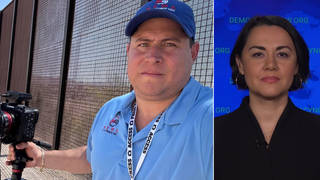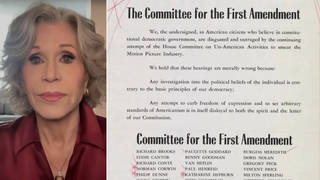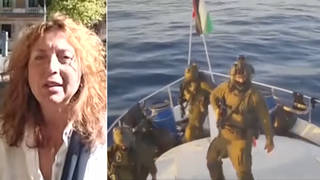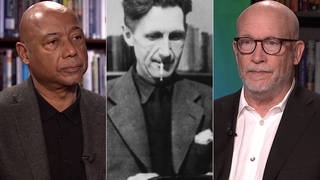
Guests
- Maria Madamba-Nunezspokesperson for Oxfam in the Philippines.
- Jeff Mastersdirector of meteorology at the Weather Underground.
- Jamela Alindogancorrespondent for Al Jazeera English reporting from Manila, Philippines.
As the Philippines reels from one of the worst storms in history, the annual U.N. climate summit is opening today in Warsaw, Poland. Jeff Masters, director of meteorology at the Weather Underground, says rising sea levels caused by global warming increased the size of the storm’s surge, while the heating of the oceans threatens more extreme storms that could form into typhoons. We also air the emotional plea of Yeb Saño, a member of the Philippines Climate Change Commission, urging action on global warming at last year’s climate summit in Doha. Saño spoke just as Typhoon Bopha hit his country, killing hundreds and leaving 250,000 homeless. “Heartbreaking tragedies like this are not unique to the Philippines, because the whole world — especially developing countries, struggling to address poverty and achieve social and human development — confront these same realities,” Saño said. “I ask of all of us here: If not us, then who? If not now, then when? If not here, then where?”
Transcript
AMY GOODMAN: News reports in the Philippines are saying people are walking around like zombies, in shock after the typhoon. Jamela, we’re also joined by Maria Madamba-Nuñez, a spokesperson from Oxfam in the Philippines. She has also made it back to Manila but has been traveling through some of these devastated areas. Maria, welcome to Democracy Now! Describe what you have seen.
MARIA MADAMBA-NUÑEZ: Oh, hi. I’ve not actually been to the areas myself, but our teams have been. And like what the Al Jazeera reporter said, that’s true: Up to now, there’s no water, no food, no electricity in Tacloban, Leyte. The pharmacies are being looted. The markets are not working. And water pipes are being punctured to get water. One mother we have interviewed said that they’ve never seen anything like this. Before, there’s just small waves, but seeing like waves two stories high. And they refer to this not as a storm surge; the way they refer to this is like a tsunami. And so, this has wiped out all of their belongings and all of—and up to now, they’ve been walking the streets and looking for food and water.
AMY GOODMAN: Can you describe the scenes that Oxfam representatives are seeing? Because the problem right now is even getting to these devastated areas, the numbers of actual counted dead perhaps numbering a thousand, but the numbers feared, 10,000—some are saying tens of thousands—whole areas that just can’t be reached.
MARIA MADAMBA-NUÑEZ: Yes, yes. Like the other humanitarian teams, you know, it keeps to be—it remains to be a challenge, I mean, accessing this area. Yeah, that’s true. The number of feared dead number from 1,000 to 10,000. Right now 9.5 million families are already affected, and that’s like double from the estimate of yesterday. That’s 10 percent—that’s almost 10 percent of the population of the whole country. And 600,000 persons are now in evacuation centers. So these are internally displaced people with no food, no water, and not even government. This is really overwhelming humanitarian capacities, both local and national capacities, in terms of delivering the life-saving goods that need to get to the affected area.
AMY GOODMAN: What needs to get there the most, Maria?
MARIA MADAMBA-NUÑEZ: It’s food, water, shelter. Right now communication lines are slowly being restored, but it’s mainly really food, water, shelter. There’s no markets, no food available in the markets. Even if you have money, if you have been able to salvage money from your belongings, there’s nothing to buy. So this is what the people are saying. And therefore you have reports of looting here.
AMY GOODMAN: Of course, looting, in times like this, it’s difficult to use that term, because what happens when people are desperate for something—for example, medication—and the people who run a store are not even there to be found.
MARIA MADAMBA-NUÑEZ: Yes, correct. And that’s why—and remember, these are the poorest provinces. The poverty incidence here is as high as 36 percent. And these belong to the bottom two, where local [inaudible]—where people are dependent on agriculture, on fisheries, and so really a very poor people, high incidence of poverty. We could be a middle-income country, but with this huge incidence of poverty and vulnerability and disasters as big as this, this will overwhelm all our resources in terms of our humanitarian capacities.
AMY GOODMAN: We’re also joined by Jeff Masters, director of meteorology at the Weather Underground. Jeff, can you explain to us what this typhoon—known as Yolanda in the Philippines, we call it Haiyan—this typhoon that’s believed to be the most powerful typhoon to ever make landfall would be a Category 6, which is not even a number as of yet?
JEFF MASTERS: That’s right. It was pretty much off our scales that we use to measure satellite intensities. We don’t actually have any measurements at the ground to verify those sort of intensities. But yeah, as far as we’ve ever seen, and using satellite imagery, I have not seen anything like this before coming in at a landfall. Usually storms weaken as they make landfall, because they interact with the high terrain, but not this one. It came in at full strength, 195 mile-per-hour winds at the surface over the ocean.
AMY GOODMAN: So explain how a typhoon like this gains power, how it’s measured. We just heard Maria of Oxfam in the Philippines saying it was like a tsunami, talking about the massive wall of water that inundates a community.
JEFF MASTERS: Typhoons take their energy from the heat of the oceans, and they convert it to the energy of their winds. In a storm like this that gets wound up to Category 5 status, it’s going to pile up a huge area of water that will then come ashore with it as it makes landfall. And that’s what happened in Tacloban. The wall of water that came in, probably at least 10 or 15 feet high, was pushed by these Category 5 winds right into the heart of this downtown area.
AMY GOODMAN: We’re also on with Jamela Alindogan, who is in the Philippines. She’s a reporter for Al Jazeera. She was in Tacloban when the typhoon hit. What you’ve heard, Jamela, as you travel on from there, on how to reach people and how preparations were made for this typhoon?
JAMELA ALINDOGAN: Well, you know, the Philippines is actually considered one of the countries that are most vulnerable to climate change. OK, let’s put the climate change factor away. But also, at about 200 typhoons hit this country every year, every year in different areas, from the northern part of the Philippines, central Philippines and northern part of Mindanao. However, the stories almost always stay the same. Emergency response is very slow. And a lot of people are looking at—this could be also—I mean, the representative of Oxfam actually made a very good point, that it is also a lot—a lot of it has to do with poverty, that most of the people who are hit by these calamities are actually those who are really at the lower sector economically. They are the ones who are most vulnerable. What has the government done? With all the typhoons and all the devastations and all the natural disasters that has hit this country, it seems as if the ability to act and ability to respond is still very much slow.
When I was already in Tacloban, in fact—and I stayed two days there trying to find a way to keep in touch and get in touch with our channel and with my family—there were almost thousands of people basically looting every single establishment that is available there. They were looting food. They were looting motorbikes. I saw a guy who was looting an entire treadmill equipment on his back. And yet, overhead, you could see military choppers flying overhead. Nothing was done. There was—there was really anarchy in the streets, you see.
And, yes, this is a very, very, very devastating—this might be, in terms of whatever scale is, in fact, out of the ordinary, but at the end of the day, you have to look at how the government has responded. They have been given days to prepare, and yet they said that they had their supplies ready, and where were these supplies? You know, in fact—and why did the military not do anything to stop the looting? Let’s just say that the looting was in fact of the food [inaudible] given. I mean, nobody was there to take the food anyway, and people were hungry. But, you know, there was actually violence that was starting already, in fact. A lot of residents who were—stayed in their houses have come to us really worried about their own safety. A lot of houses have been ransacked and looted, and their homes have been—have been attacked by men who are really just desperate to get whatever that they can get their hands on. And at the end of the day, what is important, really, is to have emergency response, to look at not just providing the immediate needs, but also to ensure that the lives of those who may have survived is secured.
I mean, the interior secretary was there days before, the secretary of defense. We were all in the same hotel. And it seems as if you ask them, they—they seem to be taken aback by this disaster. And yet, they have been warned. They—it’s been called a super typhoon. In fact, this is actually a lot very similar to Typhoon Bopha that hit the northern Philippines. Over a thousand people have been—have died, and thousands more have been—have gone missing. Millions more, in fact, have lost their homes. The numbers may have changed, the names of the disasters may have changed, but the outcome in the stories of these people is still the same. When disaster strikes, they are on their own. And unfortunately, it seems as if the Philippine government is always, always really very close and very slow in terms of responding to the needs of the people who have been affected on the ground.
AMY GOODMAN: Jeff Masters, what is the relationship between typhoons and climate change, global warming?
JEFF MASTERS: … say is that the storm surge that this storm pushed ashore would have been lower had there not been climate change. Global sea level has risen by about seven-and-a-half inches over the past 110 years, so 5, 8 percent—something like that—of the storm surge from this typhoon is due to global warming.
The other thing we can say is that these sorts of high-end Category 5 storms are likely to be more common by the end of this century, simply because with a warmer ocean you’ve got more of a heat source for these sorts of storms. Now, we don’t know about the other factors that go into making typhoons. They’re very fussy creations. You have to have a bunch of things just right to get a perfect storm like this. The upper-level winds have to be in the right position. You can’t have too much shearing force on the storm. And we’re not really sure how those factors are going to play out in a future climate. But all things equal, a hotter ocean gives you more potential for stronger storms.
AMY GOODMAN: Can you talk about how this, Jeff, compares to last year, to Typhoon Bopha? We were at the climate change summit in Doha when this devastating typhoon hit last year, considered one of the strongest.
JEFF MASTERS: Yeah, they’ve gotten three Category 5 storms in the last three—or four years now in the Philippines. And Bopha was another of these Category 5s that came onshore. And in this case, the storm’s heavy rains were what caused most of the destruction. And that’s ususally the case in the Philippines, because it’s very mountainous, there’s a lot of deforestation there. So, when it rains heavily, you tend to get a lot of runoff and flooding. But with the new storm, Yolanda, it moved relativity quickly, so it didn’t dump quite the heavy rains that Bopha did, and unfortunately the winds were much stronger than Bopha, and it piled up this massive storm surge and caused a lot of wind damage, as well.
AMY GOODMAN: Last year, when Bopha hit, Naderev Saño, known as Yeb Saño, the Philippines chief climate change commissioner, head of the Philippines climate delegation at COP19 here in Warsaw and last year in Doha, we were able to speak to him, and we spoke to him just after he had given a very emotional address talking about the devastation in his country.
NADEREV ”YEB” SAÑO: An important backdrop for my delegation is the profound impacts of climate change that we are already confronting. And as we sit here every single hour, even as we vacillate and procrastinate here, we are suffering. There is massive and widespread devastation back at home. Hundreds of thousands of people have been rendered homeless. And the ordeal is far from over.
Madam Chair, we have never had a typhoon like Bopha, which has wreaked havoc in a part of the country that has never seen a storm like this in half a century. And heartbreaking tragedies like this is not unique to the Philippines, because the whole world, especially developing countries struggling to address poverty and achieve social and human development, confront these same realities.
Finally, Madam Chair, I speak on behalf of a hundred million Filipinos, a quarter of whom—a quarter of a million of whom are eking out a living here in Qatar. And I’m making an urgent appeal, not as a negotiator, not as a leader of my delegation, but as a Filipino. I appeal to the whole world. I appeal to the leaders from all over the world to open our eyes to the stark reality that we face. I appeal to ministers. The outcome of our work is not about what our political masters want. It is about what is demanded of us by seven billion people. I appeal to all: Please, no more delays, no more excuses. Please, let Doha be remembered as the place where we found the political will to turn things around, and let 2012 be remembered as the year the world found the courage to do so, to find the courage to take responsibility for the future we want. I ask of all of us here: If not us, then who? If not now, then when? If not here, then where? Thank you, Madam Chair.
AMY GOODMAN: That was Yeb Saño, the Philippines climate change commissioner, head of the Philippines climate delegation. He was speaking last year at COP18 at the climate change summit in Doha. You can go to our website to see our extended interview with him after—this was after Typhoon Bopha hit. Now we’re dealing with Yolanda, or what we’re calling in the West, Typhoon Haiyan. Jeff Masters, it looks like the Philippines is also possibly going to be hit by a—a Tropical Depression Zoraida. What does that mean?
JEFF MASTERS: That means they are going to have trouble with the relief efforts. It’s going to slow down the airlift into the affected areas. It possibly will cause some minor flooding. It doesn’t look like this is going to be a catastrophic sort of rainfall event, but heavy rains, you know, three to six inches, over a lot of the typhoon-devastated area is very unwelcome news.
AMY GOODMAN: And the frequency of these typhoons, the—you’re talking about five level—three level fives in the last year—what causes this? And what, for you, Jeff, as you follow these storms and these patterns, is the significance of this meeting taking place in Warsaw, the COP19? We’re going to be there next week. We hoped to get Yeb Saño on today, but the opening has been delayed of the conference, so he cannot join us at this moment. But he has announced, the head of the Climate Change Commission of the Philippines, that he will begin a hunger strike until the U.N. takes some kind of action around global warming.
JEFF MASTERS: Wow! That’s impressive. Something to think about, as far as typhoons and hurricanes go, is we’ve actually been below average in activity since about 2005. And actually, in the western Pacific, this is the first year since 2004 where we’ve had above-average activity. So we haven’t had that many of these storms in the western Pacific. And the five total Category 5s that we’ve seen worldwide this year is about average. So we’ve actually been doing very well.
And the one thing I can add to that, though, is that the proportion of these sorts of high-end Category 5 storms has increased, so if we look at the total number of storms worldwide, it seems that when we do get them there’s a higher proportion of them coming in at these super high intensities. But it’s difficult to measure these things. We don’t have aircraft reconnaissance in the western Pacific. We just have satellite estimates. So there’s a lot of uncertainty about just how hurricanes and typhoons have changed over the past few decades, because our measurement capability is slow and poor.
And to the second part of your question about the Warsaw meeting, certainly having a super typhoon as the backdrop to what’s going on, as well as the fact we’ve had 35 other billion-dollar disasters on Earth so far this year, which is the second most on record behind 2010’s 40, I mean, that’s going to add a little bit of extra emphasis and a little bit of urgency perhaps to coming up with a solution. So, I’m hopeful that the Warsaw meetings will be productive. But the real big meeting we have to worry about is in Paris in 2015. That’s when we’re looking at trying to get a real climate agreement hammered out that will have some teeth.
AMY GOODMAN: I want to thank you all for being with us. Jeff Masters, joining us from Weather Underground, the director of meteorology at Weather Underground. I also want to thank our guests who have just joined us from the Philippines. Maria Madamba-Nuñez is spokesperson for Oxfam in Manila, in the Philippines. And also, very much thank you to Jamela Alindogan, reporter for Al Jazeera in the Philippines, reported live from Tacloban after Typhoon Haiyan struck, joining us from Manila. Of course, we’ll continue to cover this through the week. I’m Amy Goodman. When we come back, it’s Veterans Day.













Media Options